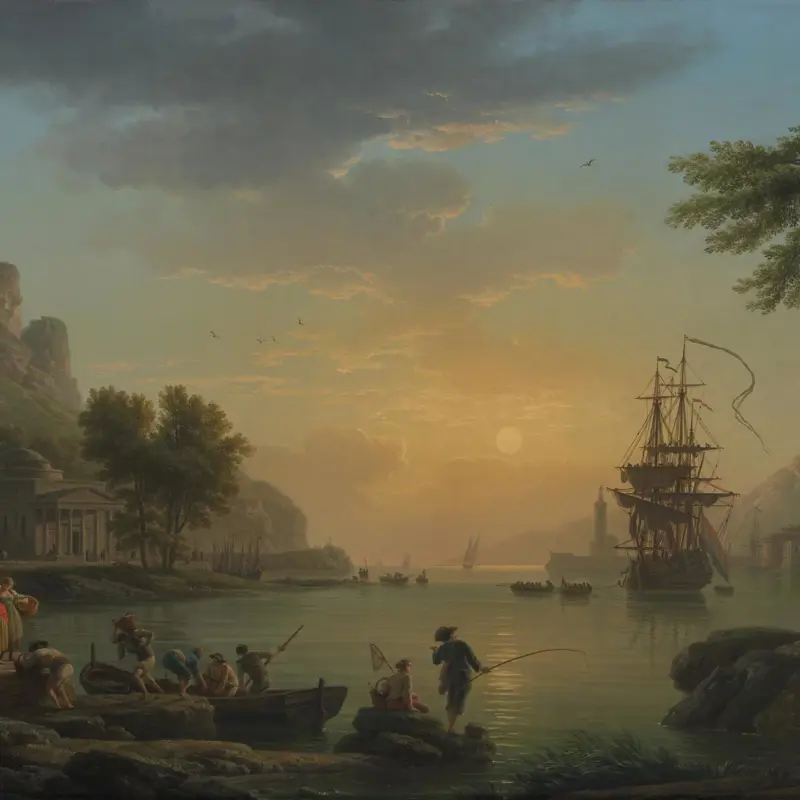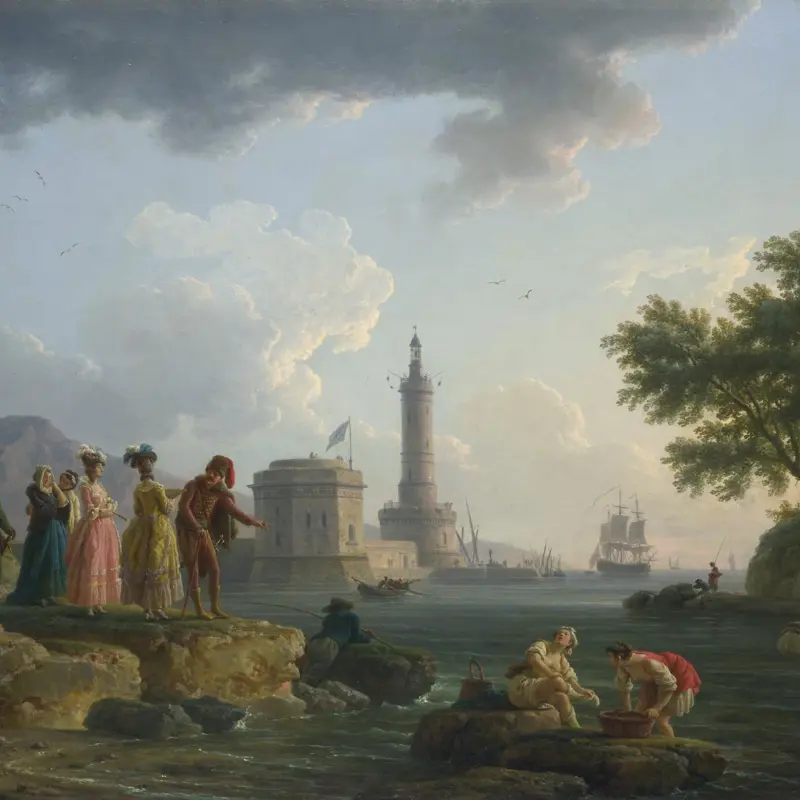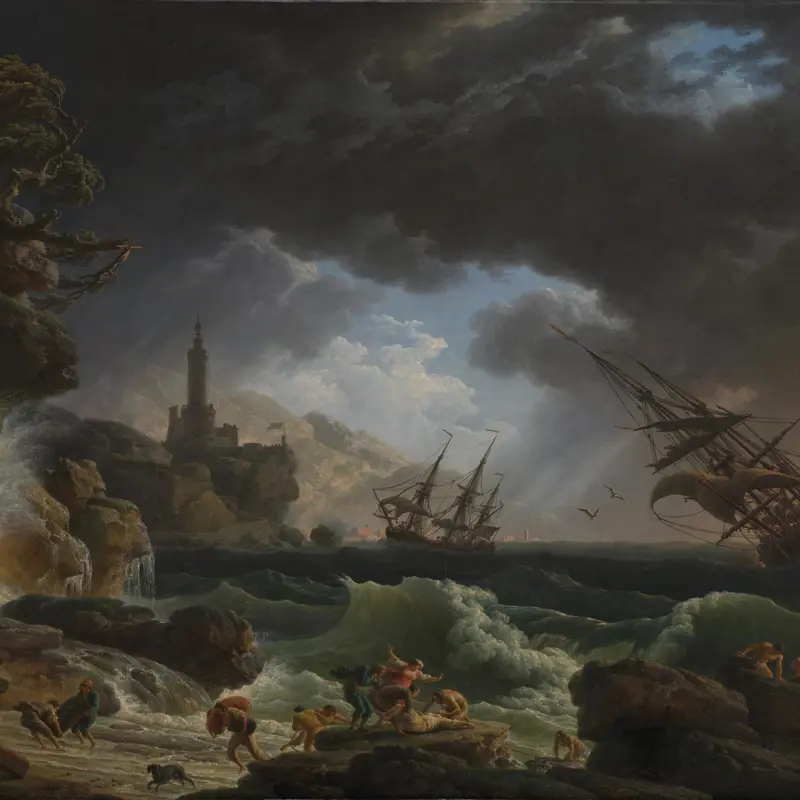Claude-Joseph Vernet, 'A Sporting Contest on the Tiber', 1750
About the work
Overview
This view is taken from the west bank of the Tiber looking towards the Castel Sant’Angelo. The specific event depicted has not been identified but river jousts were a popular official form of entertainment, and attracted large crowds of spectators.
The flag at the stern of the boat at the left bears the arms of the then pope, Benedict XIV, and four large pennants with his family arms also fly from poles attached to the Castel Sant’Angelo. It has been suggested that the painting includes portraits of Vernet, his wife and her father. However, it is more likely that the three prominent figures in the foreground are Vernet; Louis-Jules Barbon Mancini Mazarini, Duke of Nivernais, who commissioned two paintings from Vernet in 1750; and the Duke’s wife.
This was one of four paintings sent from Rome by Vernet to the Paris Salon of 1750.
Key facts
Details
- Full title
- A Sporting Contest on the Tiber
- Artist
- Claude-Joseph Vernet
- Artist dates
- 1714 - 1789
- Date made
- 1750
- Medium and support
- oil on canvas
- Dimensions
- 99.1 × 135.9 cm
- Inscription summary
- Signed; Dated
- Acquisition credit
- Presented by Mary, Lady Simpkinson, 1853
- Inventory number
- NG236
- Location
- Room 37
- Collection
- Main Collection
- Previous owners
- Frame
- 18th-century Roman Frame
Provenance
Additional information
Text extracted from the ‘Provenance’ section of the catalogue entry in Humphrey Wine, ‘National Gallery Catalogues: The Eighteenth Century French Paintings’, London 2018; for further information, see the full catalogue entry.
Exhibition history
-
2020Masterpieces from the National Gallery, LondonThe National Museum of Western Art18 June 2020 - 18 October 2020The National Museum of Art3 November 2020 - 31 January 2021
-
2021Botticelli to Van Gogh: Masterpieces from the National Gallery, LondonNational Gallery of Australia5 March 2021 - 14 June 2021
Bibliography
-
1749C.-J. Vernet, Livre de Verite, Paris 1749
-
1750Salon de 1750, Paris 1750
-
1765Vente du Marquis de Villette, Paris, 8 April 1765
-
1797J. Christie, A Catalogue of a Most Superb and Distinguished Collection of Italian, French, Flemish, and Dutch pictures, a Selection formed with Peculiar Taste and Judgment by John Trumbull, Esq., London, 17 February 1797 - 18 February 1797
-
1824W. Buchanan, Memoirs of Painting: With a Chronological History of the Importation of Pictures by the Great Masters into England Since the French Revolution, London 1824
-
1864L. Lagrange, Joseph Vernet et la peinture au XVIIIe siecle, Paris 1864
-
1869Exposition de 1750: Collection des livrets des anciennes espositions depuis 1763 jusq'en 1800, Paris 1869
-
1926F. Ingersoll-Smouse, Joseph Vernet Peintre de Marine 1714-1789, Paris 1926
-
1946Martin Davies, National Gallery Catalogues: French School, London 1946
-
1957Martin Davies, National Gallery Catalogues: French School, 2nd edn (revised), London 1957
-
1959A. Lo Bianco and A. Negro, Il Settecento a Roma, (exh. cat. Palazzo delle Esposizioni (Rome), 19 March - 31 May 1959), Rome 1959
-
1976P. Conisbee, Claude-Joseph Vernet (exh. cat. Kenwood House, 4 June - 19 September 1976), London 1976
-
1978A. Macintyre and K. Garlick (eds), The Diary of Joseph Farington, vol. 5, New Haven 1978-1984
-
1988F.W. Hawcroft, Travels in Italy 1776-1783: Based on the Memoirs of Thomas Jones (exh. cat. Whitworth Art Gallery, 7 October - 10 December 1988), Manchester 1988
-
1989National Gallery, 'Pictures Cleaned and Restored in the Conservation Department of the National Gallery, January 1989 – October 1992', National Gallery Technical Bulletin, XIV, 1993, pp. 95-6
-
1990G. Briganti, La pittura in Italia. Il Settecento, Milan 1990
-
1993R. Hudson (ed.), The Grand Tour: 1592-1796, London 1993
-
1996A. Wilton and I. Bignamini, Grand Tour: The Lure of Italy in the Eighteenth Century (exh. cat. Tate Britain, 10 October 1996 - 5 January 1997; Palazzo delle Esposizioni, 5 February - 7 April 1997), London 1996
-
2000E.P. Bowron and J.J. Rishel (eds), Art in Rome in the 18th Century (exh. cat. Philadelphia Museum of Art, 16 March - 28 May 2000; Museum of Fine Art, 25 June - 17 September 2000), Philadelphia 2000
-
2001
C. Baker and T. Henry, The National Gallery: Complete Illustrated Catalogue, London 2001
-
2018Wine, Humphrey, National Gallery Catalogues: The Eighteenth Century French Paintings, London 2018
About this record
If you know more about this work or have spotted an error, please contact us. Please note that exhibition histories are listed from 2009 onwards. Bibliographies may not be complete; more comprehensive information is available in the National Gallery Library.




